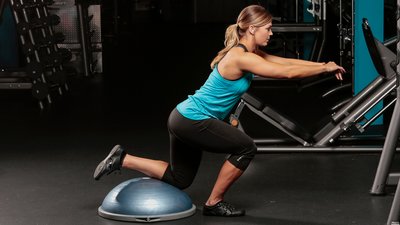The choices for your leg-day routine sometimes seem like the fare at a small-town buffet: There's nothing new on the menu, and you've had everything before. What's more, if you try it all in one sitting, only one thing's guaranteed: You won't feel good at the end of your meal!
There are a handful of great lower-body exercises and a few good variations for building muscle, but seemingly nowhere near the variety of moves you can choose from on, say, shoulder or chest day. That limitation is about to change. Today's buffet includes six leg-day moves you may be totally unfamiliar with, but they're each worth a shot to add some much-needed variety into your lower-body routine.
Providing many of the options here is Florida-based trainer Nick Tumminello, NSCA-CPT, owner of Performance University and author of "Building Muscle and Performance."
Tumminello is all about adding variety, but with a specific purpose in mind. "I'm not trying to be different for the sake of being different," he says. "Rather, I'm trying to share some things people haven't been exposed to. They may be less traditional, but that doesn't make them any less effective."
With that in mind, let's take a look at some new ways to bring back the joys of pain to your leg day!
1. Single-Leg Squat With Knee Tap
This is exactly what it sounds like—a one-legged squat in which you "tap" your nonworking knee onto a padded box directly behind you.
This exercise goes by various names, and requires good balance. To perform the bodyweight version, fold up a yoga mat and put it on top of a Reebok step so it's 4-6 inches above the floor. Put it right behind your heels. Then pick up one leg so that knee is directly behind you; the other leg becomes the sole working leg. Put your arms out straight like a zombie.
From there, perform a squat, leaning slightly forward as you descend. Try to tap your back knee lightly on the top of the box. Sit back into it just like you'd perform a barbell squat. Control the eccentric so you don't fall, then come back up in a smooth motion. Keep your shin and foot off the floor so you're not using them to assist in the upward motion, which takes stress off the working-side leg.
Single-Leg Skater Squat
Watch The Video - 1:03
Key training tip: "Balancing on one leg is harder than you think, so do this with just your body weight first, and practice the movement before adding weight," advises Tumminello. "Don't touch your shin to the box, which a lot of people want to do—touch just your knee."
To add resistance, hold a kettlebell in a racked position, or two dumbbells. Doing single-leg squats with very heavy weights is difficult, because grip tends to be a limiting factor. These are better for higher-rep sets.
2. Bulgarian Split Squat With Forward Lean
"Most Bulgarian split squats are done by keeping your torso upright, which puts a greater emphasis on the quadriceps," says Tumminello. "If you have weak quads or are trying to build them up, that version is your best option, but it's a little tougher on the knee."
This alternate version is done by leaning forward about 45 degrees. That one change shifts more torque toward your hips, creating a longer lever arm, so you use your glutes and hamstrings more.1 It's also easier on your knee joint.
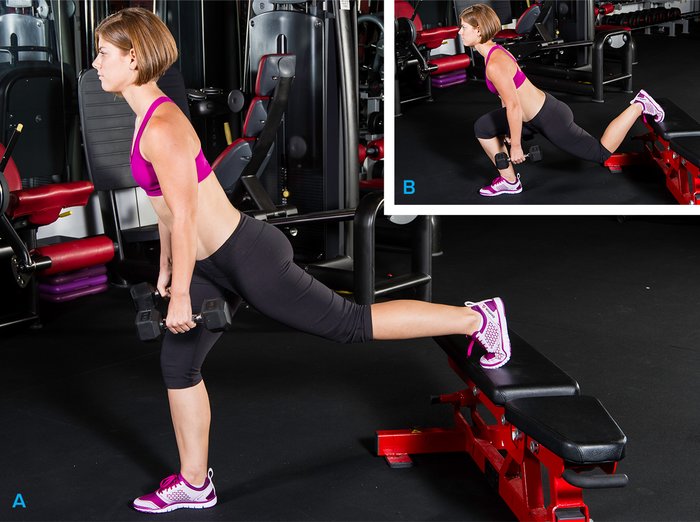
Bulgarian Split Squat With Forward Lean
Key training tip: "By leaning forward on lunges and split squats, you have the ability to create totally different exercises from their upright cousins," Tumminello says. "You can even tweak the torso angle to a greater or lesser degree. Just keep in mind that the more you lean, the more demand you put on glute and hamstring musculature."
3. Leg Extension With Toes Pointed In/Out
The leg extension is a go-to single-joint move for the end of your leg workout when you can barely stand, and even serves as a useful pre-exhaust when you want to make everything that follows a lot harder. But don't think you can't tweak it a bit to modify how the quadriceps are targeted.
The basic leg extension entails having your feet forward and toes up. In Per Tesch's book, "Target Bodybuilding," he used magnetic resonance imaging (MRI) to show this common foot position recruited all four quad muscles equally.2 While that may be no surprise, he also studied what happens when you dial your feet inward and outward slightly.
By rotating your feet inward (toes in), the outermost quad muscle, the vastus lateralis, was the most highly engaged, as well as the vastus intermedius. The two inner quad muscles received only moderate stimulation.
When the toes were then pointed in the opposite facing out, the script was flipped. Now the vastus lateralis received only moderate stimulation, while the innermost quads—the vastus medialis, rectus femoris, and vastus intermedius—bore the brunt of the movement.
By now, you're probably getting the picture that you can focus on your inner or outer quads just by repositioning your feet as you push against the ankle pad. Though leg extensions will never take the place of barbell squats in terms of muscle activation, they're useful to have in your toolbox.
Key training tip: Sit squarely in the machine with your back well-supported. All machine adjustments should be made for your body type. When turning your foot, it's actually not just the foot you're turning: Your knees should also be slightly dialed inward or outward as well. That's how you affect the muscle activation in the quads.
You may find yourself not quite as strong when rotating your feet. That's to be expected, because you're actually doing a new movement, and because some parts of the quads are no longer kicking in fully.
4. Tire Flip
You know you've always wanted to try this awesome exercise, the only downside being that you may not have a heavy tire lying around. This move provides a fun way to take a break from your usual bodybuilding exercises, especially if you do the tire flip with a friend or significant other.
Besides the lower body, the tire flip hits a number of other muscle groups as well, including the shoulders, traps, lower back, forearms, and triceps. Now remember, the weight of the tire is fixed, so if the tire's too heavy, don't compromise your form. The variables you can manipulate include number of reps, distance, rep speed, and rest periods.
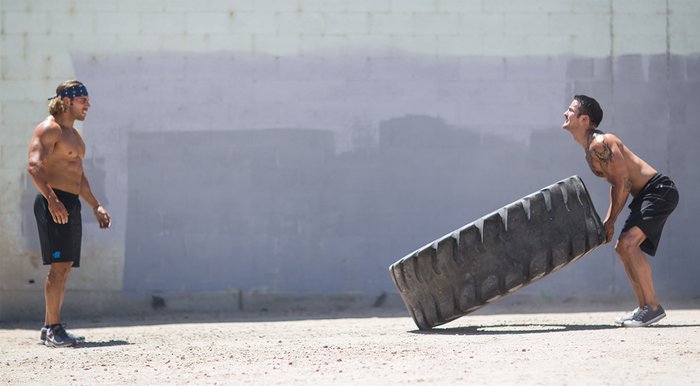
Tire Flip
This isn't a lower-back exercise, so learning good tire-flip form is essential. Make sure you squat way down with your chest driving into the tire. After that, it's all about technique and hip and knee extension.
Key training tip: Nonslip athletic shoes will help keep your feet planted on the floor. Again, make sure you focus on driving with your legs, not flipping with your back. Your butt and legs are the seat of your power, so put them to good use! This isn't a spine exercise.
5. Hybrid Deadlift
This is another Tumminello special blend; his hybrid deadlift is part RDL and part sumo. The stance is not as wide as a sumo, but not as narrow as an RDL. The foot position is up to four inches outside shoulder width on each side, and the hip-to-knee ratio of your bend is basically right in the middle too.
A sumo deadlift is really squatty—your torso stays upright and your knee bend is about 90 degrees—whereas an RDL is highly hip-dominant, since your knees bend only about 15 degrees. The hybrid is dead in the middle of both moves in terms of torso position and degree of knee bend. That means the muscle groups recruited are a mix of both back and hamstrings, as well.
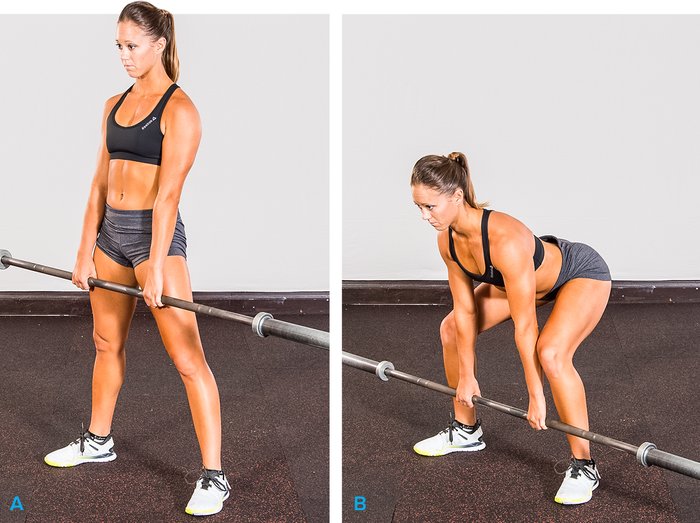
Hybrid Deadlift
"The movement is also less awkward than a sumo; it feels more natural," Tumminello says. "This hybrid concept allows you to move really big loads, but it also shares it across multiple muscle groups fairly evenly. It allows you to exert more strength and therefore feels more natural."
Key training tip: Unlike the RDL, allow the plates to lightly tap on the floor between reps. You don't need to rest between reps unless you're going very heavy, such as with a 3RM load or heavier. Always watch your back for rounding. The number of reps you do depends on your goal; it can be done for low or high reps.
6. Glute-Ham Raise
If your rear-thigh routine consists of all things leg curl and the occasional RDL, try this hamstrings move that may be flying under your radar. This glute-ham raise goes by several names, but what caught our attention most was a 2009 study that suggested the floor glute-ham raise (Russian curl or natural glute-ham raise) was the top hamstrings movement in terms of EMG activity (although that study didn't include the deadlift).3 Based on this research alone, the Russian curl is a good choice to include in your hamstring routine.
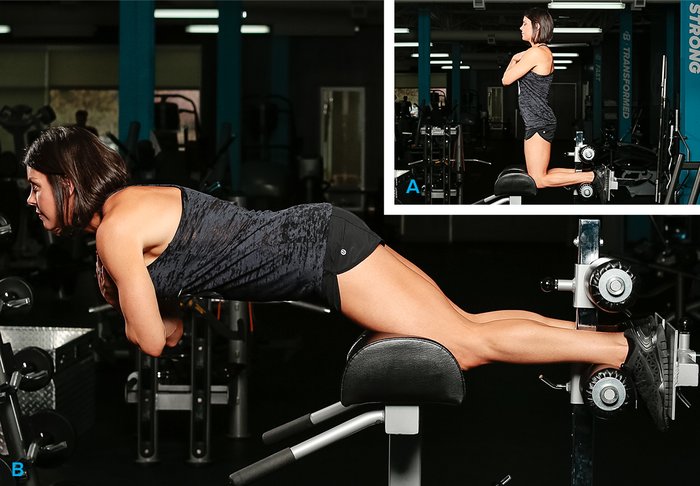
Glute-Ham Raise
Because this exercise is a bit more difficult to master (your torso is moving, not your lower legs), and it's difficult to use added weight, experiment with it as the first or last movement in your hamstrings-focused workout, depending on your strength. If you're really strong, strap on a weight vest.
Key training tip: A controlled eccentric motion is important here so you don't do a face plant into the floor. The muscle-building rep range doesn't change; stay in the 8- to 12-rep zone, achieving muscle failure on your last rep, for best results. If you do the move on an elevated lat pull-down seat, use a broomstick to help push yourself back up.
References
- Farrokhi, S., Pollard, C. D., Souza, R. B., Chen, Y. J., Reischl, S., & Powers, C. M. (2008). Trunk position influences the kinematics, kinetics, and muscle activity of the lead lower extremity during the forward lunge exercise. Journal of Orthopaedic & Sports Physical Therapy, 38(7), 403-409.
- Tesch, P. A. (1998). Target bodybuilding. Precision lifting for more mass and greater definition.
- Ebben, W. P. (2009). Hamstring activation during lower body resistance training exercises. International Journal of Sports Physiology and Performance, 4(1), 84-96.

